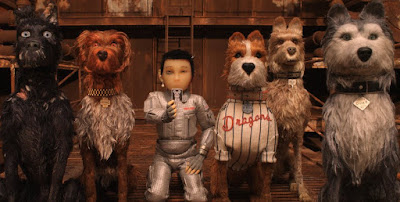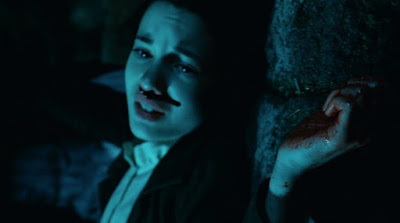Film Analysis - 'Isle of Dogs' (Directed by Wes Anderson)
Isle of Dogs. Directed (and Produced) by Wes Anderson. 2018
Official Trailer: https://www.youtube.com/watch?v=FQEx83hUPkI
Wikipedia Page (for reference): https://en.wikipedia.org/wiki/Isle_of_Dogs_(film)
Wes Anderson's Wiki Page: https://en.wikipedia.org/wiki/Wes_Anderson
The film, 'Isle of Dogs' is a charming cinematic, stop-motion experience which sticks to the original Wes Anderson of everything within the scene being perfected centred; the plot focuses heavily upon the deep seeded relationship between man and canine species and the integration of otherwise wild animals into civilised human society. With a running time of 97 minutes, the film manged to gross $64.1 million in the box office and earned a 90% approval rating on rotten tomatoes; while the film has sparked minor controversy over Asian racial stereotyping within the West, it did otherwise perform rather well in the public eye.
The film fits into a variety of genres, such as dystopian, science-fiction, comedy and drama; this allows the film to toy freely with a number of wild concepts and social messages whilst still being entertaining for the audience. One of the most prominent messages throughout the film's plot is the harm industrialisation causes to the planet and ultimately how the cruelty of human kind grows to spark new growth and resistance within small societal bodies; the plot stakes its claim on the idea of community and chooses to portray ideas of loyalty and honour through canine species, suggesting that our more bestial counterpart has outgrown us in terms of morality, or perhaps we have simply lost our integrity as human beings. Many scenes within the film depict harsh, toxic, industrious landscapes where even the lighting and chosen colour pallet seems polluted, usually resulting in many background set pieces having musty-brown hues covering their exteriors; this visual bombardment of negativity allows the audience to feel a certain level of guilt which comes with being a human in this modern age, each shot in these environments perfectly captures our blissful misuse of the planet and its resources.
Each of the figures in the film are remarkable in terms of visual detail and craftsmanship, unlike most other stop-motion production companies (such as studio Laika), all the facial variants within this film were carefully hand sculpted by expert craftsmen, whereas most studios use 3D printing for most of their models faces. This technique is a strange choice to make considering that it greatly increases the work load for all the (employed) model sculptors, easily adding on 100's of additional man hours when a machine could quite easily have done the work for them with near expert-level precision.
In terms of audio, the film sports an impressive collection of Japanese themed musical numbers, each helping to capture elements of rich Asian culture which can be passively absorbed during the film's run time. Scenes can be found often building tension through the use of loud, repetitive wooden instruments, through this technique they are able to introduce subtle western elements into the film which organically coincide with many of the present Japanese themes and concepts.
Official Trailer: https://www.youtube.com/watch?v=FQEx83hUPkI
Wikipedia Page (for reference): https://en.wikipedia.org/wiki/Isle_of_Dogs_(film)
Wes Anderson's Wiki Page: https://en.wikipedia.org/wiki/Wes_Anderson
The film, 'Isle of Dogs' is a charming cinematic, stop-motion experience which sticks to the original Wes Anderson of everything within the scene being perfected centred; the plot focuses heavily upon the deep seeded relationship between man and canine species and the integration of otherwise wild animals into civilised human society. With a running time of 97 minutes, the film manged to gross $64.1 million in the box office and earned a 90% approval rating on rotten tomatoes; while the film has sparked minor controversy over Asian racial stereotyping within the West, it did otherwise perform rather well in the public eye.
The film fits into a variety of genres, such as dystopian, science-fiction, comedy and drama; this allows the film to toy freely with a number of wild concepts and social messages whilst still being entertaining for the audience. One of the most prominent messages throughout the film's plot is the harm industrialisation causes to the planet and ultimately how the cruelty of human kind grows to spark new growth and resistance within small societal bodies; the plot stakes its claim on the idea of community and chooses to portray ideas of loyalty and honour through canine species, suggesting that our more bestial counterpart has outgrown us in terms of morality, or perhaps we have simply lost our integrity as human beings. Many scenes within the film depict harsh, toxic, industrious landscapes where even the lighting and chosen colour pallet seems polluted, usually resulting in many background set pieces having musty-brown hues covering their exteriors; this visual bombardment of negativity allows the audience to feel a certain level of guilt which comes with being a human in this modern age, each shot in these environments perfectly captures our blissful misuse of the planet and its resources.
Each of the figures in the film are remarkable in terms of visual detail and craftsmanship, unlike most other stop-motion production companies (such as studio Laika), all the facial variants within this film were carefully hand sculpted by expert craftsmen, whereas most studios use 3D printing for most of their models faces. This technique is a strange choice to make considering that it greatly increases the work load for all the (employed) model sculptors, easily adding on 100's of additional man hours when a machine could quite easily have done the work for them with near expert-level precision.
In terms of audio, the film sports an impressive collection of Japanese themed musical numbers, each helping to capture elements of rich Asian culture which can be passively absorbed during the film's run time. Scenes can be found often building tension through the use of loud, repetitive wooden instruments, through this technique they are able to introduce subtle western elements into the film which organically coincide with many of the present Japanese themes and concepts.





Comments
Post a Comment